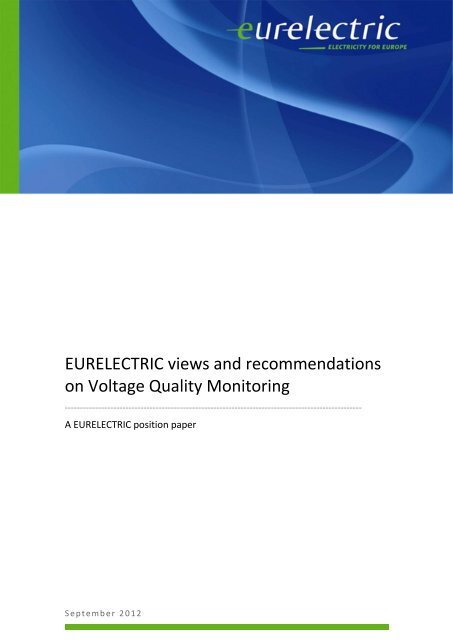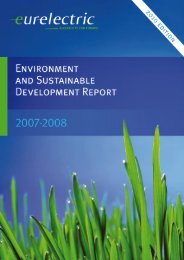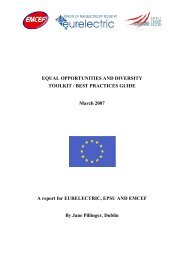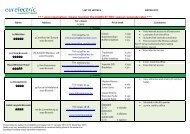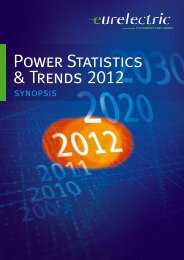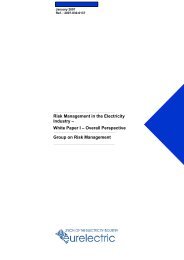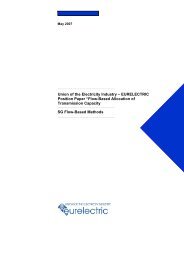EURELECTRIC views and recommendations on Voltage Quality ...
EURELECTRIC views and recommendations on Voltage Quality ...
EURELECTRIC views and recommendations on Voltage Quality ...
Create successful ePaper yourself
Turn your PDF publications into a flip-book with our unique Google optimized e-Paper software.
<str<strong>on</strong>g>EURELECTRIC</str<strong>on</strong>g> <str<strong>on</strong>g>views</str<strong>on</strong>g> <str<strong>on</strong>g>and</str<strong>on</strong>g> <str<strong>on</strong>g>recommendati<strong>on</strong>s</str<strong>on</strong>g><br />
<strong>on</strong> <strong>Voltage</strong> <strong>Quality</strong> M<strong>on</strong>itoring<br />
--------------------------------------------------------------------------------------------------<br />
A <str<strong>on</strong>g>EURELECTRIC</str<strong>on</strong>g> positi<strong>on</strong> paper<br />
S e p t e m b e r 2 0 1 2
The Uni<strong>on</strong> of the Electricity Industry–<str<strong>on</strong>g>EURELECTRIC</str<strong>on</strong>g> is the sector associati<strong>on</strong> representing the comm<strong>on</strong> interests of the<br />
electricity industry at pan-European level, plus its affiliates <str<strong>on</strong>g>and</str<strong>on</strong>g> associates <strong>on</strong> several other c<strong>on</strong>tinents.<br />
In line with its missi<strong>on</strong>, <str<strong>on</strong>g>EURELECTRIC</str<strong>on</strong>g> seeks to c<strong>on</strong>tribute to the competitiveness of the electricity industry, to provide<br />
effective representati<strong>on</strong> for the industry in public affairs, <str<strong>on</strong>g>and</str<strong>on</strong>g> to promote the role of electricity both in the<br />
advancement of society <str<strong>on</strong>g>and</str<strong>on</strong>g> in helping provide soluti<strong>on</strong>s to the challenges of sustainable development.<br />
<str<strong>on</strong>g>EURELECTRIC</str<strong>on</strong>g>’s formal opini<strong>on</strong>s, policy positi<strong>on</strong>s <str<strong>on</strong>g>and</str<strong>on</strong>g> reports are formulated in Working Groups, composed of experts<br />
from the electricity industry, supervised by five Committees. This “structure of expertise” ensures that <str<strong>on</strong>g>EURELECTRIC</str<strong>on</strong>g>’s<br />
published documents are based <strong>on</strong> high-quality input with up-to-date informati<strong>on</strong>.<br />
For further informati<strong>on</strong> <strong>on</strong> <str<strong>on</strong>g>EURELECTRIC</str<strong>on</strong>g> activities, visit our website, which provides general informati<strong>on</strong> <strong>on</strong> the<br />
associati<strong>on</strong> <str<strong>on</strong>g>and</str<strong>on</strong>g> <strong>on</strong> policy issues relevant to the electricity industry; latest news of our activities; <str<strong>on</strong>g>EURELECTRIC</str<strong>on</strong>g> positi<strong>on</strong>s<br />
<str<strong>on</strong>g>and</str<strong>on</strong>g> statements; a publicati<strong>on</strong>s catalogue listing <str<strong>on</strong>g>EURELECTRIC</str<strong>on</strong>g> reports; <str<strong>on</strong>g>and</str<strong>on</strong>g> informati<strong>on</strong> <strong>on</strong> our events <str<strong>on</strong>g>and</str<strong>on</strong>g> c<strong>on</strong>ferences.<br />
<str<strong>on</strong>g>EURELECTRIC</str<strong>on</strong>g> pursues in all its activities the applicati<strong>on</strong> of<br />
the following sustainable development values:<br />
Ec<strong>on</strong>omic Development<br />
Growth, added-value, efficiency<br />
Envir<strong>on</strong>mental Leadership<br />
Commitment, innovati<strong>on</strong>, pro-activeness<br />
Social Resp<strong>on</strong>sibility<br />
Transparency, ethics, accountability<br />
Dépôt légal: D/2012/12.105/40<br />
2
<str<strong>on</strong>g>EURELECTRIC</str<strong>on</strong>g> <str<strong>on</strong>g>views</str<strong>on</strong>g> <str<strong>on</strong>g>and</str<strong>on</strong>g> <str<strong>on</strong>g>recommendati<strong>on</strong>s</str<strong>on</strong>g> <strong>on</strong> <strong>Voltage</strong><br />
<strong>Quality</strong> M<strong>on</strong>itoring<br />
--------------------------------------------------------------------------------------------------<br />
WG St<str<strong>on</strong>g>and</str<strong>on</strong>g>ardisati<strong>on</strong><br />
Giovanni VALTORTA (IT) Chair<br />
Janusz BAK (PL); Martins BUDAHS (LV); David F. CRAWLEY (GB); Miroslav DUBOVSKY (SK); Michel GOLDBERG<br />
(FR); Olivier GOURLAY (FR); Tassos GREGORIOU (CY); Jens Zoëga HANSEN (DK); Hansjörg HOLENSTEIN (CH);<br />
Ignacio ISLA (ES); Johan JANSSEN (NL); Tuomas MAASALO (FI); Francisco MIRA (PT); Stanislav MOTEJZIK (CZ);<br />
Per NORBERG (SE); Gert PASCOLI (AT); Joachim PESTKA (DE); Mirko RISTEVSKI (); Hervé ROCHEREAU (FR); Jose<br />
Maria ROMERO GORDON (ES); Maurice ROOVERS (NL); Kjell SAND (NO); Mark SCHOCKE (DE); Dan<br />
STANCULESCU (RO); Marijana SUCEVIC -TASIC (RS); K<strong>on</strong>rad TYRAJSKI (PL); Eric VAN ASSCHE (BE); Wouter<br />
VANCOETSEM (BE); Annousa VENIERI (GR); Anth<strong>on</strong>y WALSH (IE); Jozsef ZERENYI (HU); Mareks ZVIEDRITIS (LV);<br />
C<strong>on</strong>tact:<br />
Sophie Tielemans, Advisor Networks Unit - stielemans@eurelectric.org<br />
Gunnar Lorenz, Head of Networks Unit – glorenz@eurelectric.org<br />
3
Introductory remarks <strong>on</strong> voltage quality<br />
The quality of voltage is influenced by network characteristics <str<strong>on</strong>g>and</str<strong>on</strong>g> structure, by faults <str<strong>on</strong>g>and</str<strong>on</strong>g> how those<br />
faults are detected <str<strong>on</strong>g>and</str<strong>on</strong>g> selected, as well as by the equipment of the network users <str<strong>on</strong>g>and</str<strong>on</strong>g> how that<br />
equipment is used. Equipment <str<strong>on</strong>g>and</str<strong>on</strong>g> network users can either act as a dem<str<strong>on</strong>g>and</str<strong>on</strong>g> (load) or a producti<strong>on</strong> unit<br />
(producer).<br />
In this complex c<strong>on</strong>text, determining the party resp<strong>on</strong>sible for the voltage disturbance (network<br />
operator, a neighbouring network, or <strong>on</strong>e (or all) of the c<strong>on</strong>nected end-users) is a difficult task. A clear<br />
procedure for resp<strong>on</strong>sibility sharing between the involved stakeholders ( TSOs, DSOs, equipment<br />
manufacturers <str<strong>on</strong>g>and</str<strong>on</strong>g> users) is therefore crucial. A correct balance must be struck between network<br />
performance <str<strong>on</strong>g>and</str<strong>on</strong>g> immunity requirements for customer equipment, to ensure that extra costs are paid by<br />
those who benefit <str<strong>on</strong>g>and</str<strong>on</strong>g> that the overall benefits to society are greater than overall costs.<br />
<strong>Voltage</strong> quality differs between countries, types of network ( e.g. cable, overhead line, grounding) <str<strong>on</strong>g>and</str<strong>on</strong>g><br />
rural/urban areas. A regulatory obligati<strong>on</strong> to fulfil the same high voltage quality requirements across the<br />
whole of Europe is therefore unrealistic. <strong>Voltage</strong> quality regulati<strong>on</strong> should be tailored in such a way as<br />
to take the specific characteristics of an individual network <str<strong>on</strong>g>and</str<strong>on</strong>g> local network c<strong>on</strong>diti<strong>on</strong>s into account.<br />
<str<strong>on</strong>g>EURELECTRIC</str<strong>on</strong>g> DSOs believe that the EN50160 st<str<strong>on</strong>g>and</str<strong>on</strong>g>ard represents a solid basis for guaranteeing a<br />
reas<strong>on</strong>able level of voltage quality under normal network c<strong>on</strong>diti<strong>on</strong>s.<br />
<strong>Voltage</strong> quality management is a shared resp<strong>on</strong>sibility: strike a balance between network<br />
improvements <str<strong>on</strong>g>and</str<strong>on</strong>g> clean/resilient equipment 1<br />
<strong>Voltage</strong> quality is not determined by the network operator al<strong>on</strong>e. Rather, voltage disturbances are often<br />
caused by accidental faults <str<strong>on</strong>g>and</str<strong>on</strong>g> by the network users themselves, both upstream <str<strong>on</strong>g>and</str<strong>on</strong>g> downstream.<br />
Indeed, the electrical installati<strong>on</strong>s of c<strong>on</strong>nected network users locally affect the voltage quality by how<br />
they draw t current from the system (harm<strong>on</strong>ic distorti<strong>on</strong>, transient behaviour <str<strong>on</strong>g>and</str<strong>on</strong>g> the use over time).<br />
<strong>Voltage</strong> quality also depends <strong>on</strong> the characteristics of electrical <str<strong>on</strong>g>and</str<strong>on</strong>g> electr<strong>on</strong>ic home appliances <str<strong>on</strong>g>and</str<strong>on</strong>g> of<br />
network interfaces for distributed generati<strong>on</strong>. Product st<str<strong>on</strong>g>and</str<strong>on</strong>g>ards with appropriate requirements (e.g.<br />
emissi<strong>on</strong> limits) <str<strong>on</strong>g>and</str<strong>on</strong>g> c<strong>on</strong>necti<strong>on</strong> requirements linked to a reliable c<strong>on</strong>formity assessment system are<br />
necessary to ensure quality of supply. Additi<strong>on</strong>ally, voltage quality is becoming ever more challenging<br />
due to an increased susceptibility of end-user equipment <str<strong>on</strong>g>and</str<strong>on</strong>g> industrial installati<strong>on</strong>s to voltage<br />
disturbances.<br />
The c<strong>on</strong>siderati<strong>on</strong>s above make it quite obvious that the network operator cannot be held solely<br />
resp<strong>on</strong>sible for voltage quality management. There should be a clear process in place that defines the<br />
resp<strong>on</strong>sibility in case of voltage disturbances. C<strong>on</strong>trolling emissi<strong>on</strong> from network end-users is necessary.<br />
It can be performed if:<br />
For mass-market products, emissi<strong>on</strong> requirements in product st<str<strong>on</strong>g>and</str<strong>on</strong>g>ards are appropriate,<br />
For large installati<strong>on</strong>s, emissi<strong>on</strong> levels are effectively c<strong>on</strong>trolled, e.g. through c<strong>on</strong>necti<strong>on</strong><br />
agreements,<br />
Appropriate methodologies <str<strong>on</strong>g>and</str<strong>on</strong>g> engineering practices are used, e.g. based <strong>on</strong> planning levels<br />
<str<strong>on</strong>g>and</str<strong>on</strong>g> IEC/TR 61000-3-6, 3-7, 3-13 <str<strong>on</strong>g>and</str<strong>on</strong>g>/or 3-14.<br />
1 This covers mainly large industrial end-users <strong>on</strong> the MV or HV networks<br />
4
Significant improvements in voltage quality can <strong>on</strong>ly occur together with major immunity requirements<br />
for equipment <str<strong>on</strong>g>and</str<strong>on</strong>g> industrial processes. Improvements to equipment are necessary to effectively <str<strong>on</strong>g>and</str<strong>on</strong>g><br />
ec<strong>on</strong>omically safeguard system performance against voltage dips. In this regard, <str<strong>on</strong>g>EURELECTRIC</str<strong>on</strong>g><br />
welcomes the cooperati<strong>on</strong> with manufacturers reviewing electromagnetic compatibility requirements.<br />
TSOs have understood that the <strong>on</strong>ly way to effectively improve the ride-through capability is to correctly<br />
immunise generators. A similar approach should be applied to equipment <strong>on</strong> the c<strong>on</strong>sumer side.<br />
In sum, maintaining <str<strong>on</strong>g>and</str<strong>on</strong>g>/or achieving an appropriate voltage quality in distributi<strong>on</strong> networks is a<br />
shared resp<strong>on</strong>sibility between TSOs, DSOs, equipment manufacturers <str<strong>on</strong>g>and</str<strong>on</strong>g> c<strong>on</strong>nected end-users.<br />
Ensuring voltage quality at reas<strong>on</strong>able cost requires, <strong>on</strong> the <strong>on</strong>e h<str<strong>on</strong>g>and</str<strong>on</strong>g>, imposing preventative measures,<br />
i.e. appropriate emissi<strong>on</strong> <str<strong>on</strong>g>and</str<strong>on</strong>g> immunity limits for customer equipment <str<strong>on</strong>g>and</str<strong>on</strong>g>/or installati<strong>on</strong>s, <str<strong>on</strong>g>and</str<strong>on</strong>g> <strong>on</strong> the<br />
other h<str<strong>on</strong>g>and</str<strong>on</strong>g>, improving <str<strong>on</strong>g>and</str<strong>on</strong>g> strengthening the network.<br />
The cost of mitigating the impact of voltage disturbances <strong>on</strong> equipment <str<strong>on</strong>g>and</str<strong>on</strong>g> the network should also be<br />
examined. <str<strong>on</strong>g>EURELECTRIC</str<strong>on</strong>g> therefore recommends c<strong>on</strong>ducting a study <strong>on</strong> voltage disturbances to assess<br />
the actual impact of various voltage disturbances <strong>on</strong> equipment in order to evaluate the need for <str<strong>on</strong>g>and</str<strong>on</strong>g><br />
feasibility of establishing (an) immunity curve(s). It should be noted that the immunity curve approach<br />
may not be appropriate for all types of disturbance <str<strong>on</strong>g>and</str<strong>on</strong>g> customer.<br />
<strong>Voltage</strong> quality in evolving distributi<strong>on</strong> networks<br />
<strong>Voltage</strong> quality will increasingly be affected by developments such as the proliferati<strong>on</strong> of distributed<br />
generati<strong>on</strong>, charging of electric cars, <str<strong>on</strong>g>and</str<strong>on</strong>g> increased use of energy-efficient equipment <str<strong>on</strong>g>and</str<strong>on</strong>g> appliances<br />
(usually n<strong>on</strong>-linear loads). New loads <str<strong>on</strong>g>and</str<strong>on</strong>g> units c<strong>on</strong>nected to the network (e.g. photovoltaic installati<strong>on</strong>s,<br />
electric cars, inverters) must comply with st<str<strong>on</strong>g>and</str<strong>on</strong>g>ards <str<strong>on</strong>g>and</str<strong>on</strong>g> grid codes. History shows that voltage quality<br />
comes under pressure when the majority of customers suddenly ‘move in the same directi<strong>on</strong>’ (e.g. by<br />
installing photovoltaic in their homes). In these cases voltage quality may suddenly become a significant<br />
problem. A c<strong>on</strong>tinuous dialogue am<strong>on</strong>g DSOs – <str<strong>on</strong>g>and</str<strong>on</strong>g> to some extent with CEER/nati<strong>on</strong>al regulators – must<br />
be held to foster cooperati<strong>on</strong> <strong>on</strong> voltage quality measurement programmes. The resulting data can be<br />
used in the st<str<strong>on</strong>g>and</str<strong>on</strong>g>ardisati<strong>on</strong> process <str<strong>on</strong>g>and</str<strong>on</strong>g> in nati<strong>on</strong>al regulati<strong>on</strong>.<br />
<strong>Voltage</strong> quality st<str<strong>on</strong>g>and</str<strong>on</strong>g>ards are currently <strong>on</strong>e of the greatest impediments to dispersed renewable<br />
generati<strong>on</strong>: they limit the size <str<strong>on</strong>g>and</str<strong>on</strong>g> c<strong>on</strong>necti<strong>on</strong> method of wind farms <str<strong>on</strong>g>and</str<strong>on</strong>g> other renewables <str<strong>on</strong>g>and</str<strong>on</strong>g> will also<br />
apply to solar panels, electric cars <str<strong>on</strong>g>and</str<strong>on</strong>g> heat pumps. Real problems might arise if voltage quality<br />
requirements are excessively severe. For example, maintaining voltage variati<strong>on</strong>s that are too low might<br />
make it impossible to install distributed generati<strong>on</strong>. Certain nati<strong>on</strong>al regulati<strong>on</strong> – like the ±7% in Spain or<br />
the 1-minute average in Norway – may reduce the hosting capacity of LV lines for distributed generators<br />
<str<strong>on</strong>g>and</str<strong>on</strong>g> fast (high power) electric vehicle chargers. Regulators should take this into careful c<strong>on</strong>siderati<strong>on</strong>.<br />
Generally, <str<strong>on</strong>g>EURELECTRIC</str<strong>on</strong>g> believes that dem<str<strong>on</strong>g>and</str<strong>on</strong>g>s for stricter nati<strong>on</strong>al regulati<strong>on</strong> should be driven by a<br />
technical-ec<strong>on</strong>omic analysis that justifies those stricter dem<str<strong>on</strong>g>and</str<strong>on</strong>g>s. Such a cost-benefit analysis should<br />
include network issues such as pre-ageing of assets <str<strong>on</strong>g>and</str<strong>on</strong>g> effects <strong>on</strong> reactive balances.<br />
5
M<strong>on</strong>itoring voltage quality: c<strong>on</strong>siderati<strong>on</strong>s <str<strong>on</strong>g>and</str<strong>on</strong>g> <str<strong>on</strong>g>recommendati<strong>on</strong>s</str<strong>on</strong>g><br />
DSOs measure voltage quality 2 <strong>on</strong> a regular basis. The m<strong>on</strong>itoring programmes provide data that may<br />
enable smoother network operati<strong>on</strong>, avoid possible faults, ensure better network planning, <str<strong>on</strong>g>and</str<strong>on</strong>g> detect<br />
faults <str<strong>on</strong>g>and</str<strong>on</strong>g> disturbances.<br />
Regulators must take two aspects of voltage m<strong>on</strong>itoring into account:<br />
- The interpretati<strong>on</strong> of such data is not yet harm<strong>on</strong>ised <strong>on</strong> a European scale; a harm<strong>on</strong>ised format<br />
is needed to ensure a uniform data interpretati<strong>on</strong> across Europe. A st<str<strong>on</strong>g>and</str<strong>on</strong>g>ard template for<br />
reporting data to nati<strong>on</strong>al regulators would provide added-value to all stakeholders. This<br />
st<str<strong>on</strong>g>and</str<strong>on</strong>g>ard report could include the durati<strong>on</strong> of m<strong>on</strong>itoring campaigns, measurement methods,<br />
phase <str<strong>on</strong>g>and</str<strong>on</strong>g> time aggregati<strong>on</strong> methods for voltage quality events, flagging <str<strong>on</strong>g>and</str<strong>on</strong>g> data exclusi<strong>on</strong><br />
criteria. The template would result in a uniform report that is independent of recording devices<br />
<str<strong>on</strong>g>and</str<strong>on</strong>g> could serve as a reference for developers of voltage quality management systems looking to<br />
improve reporting tools. The broad adopti<strong>on</strong> of a st<str<strong>on</strong>g>and</str<strong>on</strong>g>ard report would also facilitate voltage<br />
quality benchmarking between European regi<strong>on</strong>s. A first step has already been taken with EN<br />
50160:2010, e.g. for a st<str<strong>on</strong>g>and</str<strong>on</strong>g>ardised classificati<strong>on</strong> of voltage dips.<br />
- In several EU member states the cost of voltage m<strong>on</strong>itoring is not recognised as a distributi<strong>on</strong><br />
cost. As a result the DSOs in those countries lack resources to set up proper m<strong>on</strong>itoring schemes.<br />
<str<strong>on</strong>g>EURELECTRIC</str<strong>on</strong>g> DSOs questi<strong>on</strong> the necessity of introducing additi<strong>on</strong>al voltage quality requirements that<br />
are stricter than the current st<str<strong>on</strong>g>and</str<strong>on</strong>g>ard, as this may lead to higher <str<strong>on</strong>g>and</str<strong>on</strong>g> possibly unnecessary costs for<br />
society, especially because <strong>on</strong>ly few customers suffer from voltage quality problems. Moreover, ‘local’<br />
soluti<strong>on</strong>s to voltage variati<strong>on</strong>s prove to be much more technically <str<strong>on</strong>g>and</str<strong>on</strong>g> ec<strong>on</strong>omically effective. Therefore<br />
<str<strong>on</strong>g>EURELECTRIC</str<strong>on</strong>g> promotes a wide voltage quality measurement campaign based <strong>on</strong> EN50160.<br />
M<strong>on</strong>itoring voltage quality in the LV network: the role of smart meters<br />
Rolling out smart meters opens up the possibility of collecting crude indicators <strong>on</strong> voltage variati<strong>on</strong>s,<br />
interrupti<strong>on</strong>s <str<strong>on</strong>g>and</str<strong>on</strong>g> sometimes dips <str<strong>on</strong>g>and</str<strong>on</strong>g> swells at end customers’ c<strong>on</strong>necti<strong>on</strong> points. Such indicators could,<br />
for example, show sustained over-voltage <str<strong>on</strong>g>and</str<strong>on</strong>g> under-voltage due to electric cars <str<strong>on</strong>g>and</str<strong>on</strong>g> distributed<br />
generati<strong>on</strong>.<br />
However, such crude data should not be used as a basis for regulatory acti<strong>on</strong>. Instead, <str<strong>on</strong>g>EURELECTRIC</str<strong>on</strong>g><br />
believes that decisi<strong>on</strong>s <strong>on</strong> possible regulatory acti<strong>on</strong> should be taken based <strong>on</strong> the actual impact of<br />
voltage disturbances <strong>on</strong> customers, as measured by cross-checking voltage disturbances against<br />
customer complaints <str<strong>on</strong>g>and</str<strong>on</strong>g> referenced to the original cause in order to avoid multiple counts or customermade<br />
disturbances. To thoroughly underst<str<strong>on</strong>g>and</str<strong>on</strong>g> <str<strong>on</strong>g>and</str<strong>on</strong>g> h<str<strong>on</strong>g>and</str<strong>on</strong>g>le voltage disturbances, the smart metering<br />
m<strong>on</strong>itoring must be complemented by dedicated <str<strong>on</strong>g>and</str<strong>on</strong>g> sophisticated voltage m<strong>on</strong>itoring devices at<br />
MV/LV substati<strong>on</strong>s. It must also be recognised that not all voltage disturbances necessarily result in<br />
negative effects for end-users.<br />
2 <strong>Voltage</strong> <strong>Quality</strong> (VQ) covers a wide range of voltage disturbances <str<strong>on</strong>g>and</str<strong>on</strong>g> deviati<strong>on</strong>s in voltage magnitude or the voltage<br />
waveform. Examples of voltage disturbances include supply voltage variati<strong>on</strong>s, harm<strong>on</strong>ic voltage, voltage dips, <str<strong>on</strong>g>and</str<strong>on</strong>g> other voltage<br />
transients. Generally the MV <str<strong>on</strong>g>and</str<strong>on</strong>g> HV networks are mostly affected by voltage dips whereas the LV networks are mainly affected<br />
by voltage variati<strong>on</strong>s, harm<strong>on</strong>ics <str<strong>on</strong>g>and</str<strong>on</strong>g> flicker.<br />
6
Uni<strong>on</strong> of the Electricity Industry - <str<strong>on</strong>g>EURELECTRIC</str<strong>on</strong>g> aisbl<br />
Boulevard de l’Impératrice, 66 - bte 2<br />
B - 1000 Brussels • Belgium<br />
Tel: + 32 2 515 10 00 • Fax: + 32 2 515 10 10<br />
VAT: BE 0462 679 112 • www.eurelectric..org


